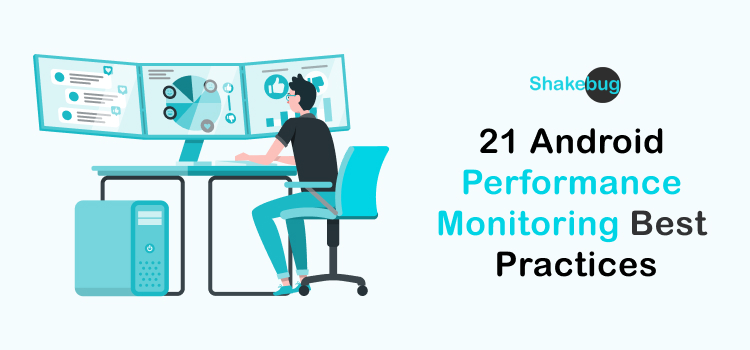Performance monitoring is an important part of any Android app development process. It helps to identify and address potential performance issues before they become a problem for users. In this article, we will discuss 21 best practices for Android performance monitoring that can help you ensure the highest levels of quality in your apps.
We’ll cover topics such as testing strategies, debugging techniques, memory management tips, and more. By following these guidelines, you can make sure your apps are running smoothly on all devices and operating systems.
1. Use Profiling Tools
Profiling tools can help you locate any possible problems with the code of your application and provide you with a sense of how well it is operating in terms of memory usage, CPU utilization, battery consumption, and other areas.
Regular use of these mobile app development tools allows developers to identify issues early on and address them before they become serious problems that could compromise user experience or result in crashes. Regular profiling will also enable developers to assess whether there have been any advancements or regressions over time by enabling them to compare their current version against earlier iterations.
2. Monitor Frame Rate
The number of frames displayed on a device in a second is known as the frame rate, and if it gets too low, it may affect the user experience. Developers can spot potential performance issues with their app and take appropriate action by monitoring the frame rate over time.
They should also think about utilizing programs like GPU Profiler or Systrace, which offer more thorough details about the operation of the program at any given time. Then, by streamlining the code or using less memory, this data can be utilized to enhance overall performance.
3. Leverage Crash Reporting
Using bug reporting for app optimization is one of the best ways to track Android performance. Crash reports offer insightful information about the stability of your program and can be used to find potential causes of crashes and other issues. You can rapidly identify areas that require improvement to guarantee a better user experience by utilizing crash reporting.
Furthermore, by monitoring crash data over time, you can learn how modifications impact overall performance and adapt your strategy accordingly.
4. Network Request Monitoring
Among the 21 best practices for tracking Android performance is network request monitoring. It involves monitoring and assessing network requests to make sure the system is operating effectively and to spot any possible problems or bottlenecks. You can find areas that might benefit from optimizations, like better bandwidth utilization or latency reduction.
By ensuring a seamless experience across all devices, developers can use this technique to enhance the overall performance and user experience of their app.
5. Memory Leak Detection
One of the best methods for monitoring Android performance is Memory Leak Detection. It aids in locating any memory leaks that might be happening within an application, which can cause instability and subpar performance.
The process includes monitoring the amount of memory each feature or component of an application consumes over time, allowing developers to identify potential problems with their code. Early problem detection allows developers to address these issues before they grow into more significant ones later on.
6. Optimize Layout Hierarchies
Layout hierarchy optimization is one of the Best Practices for Android Performance Monitoring. This implies that designers should optimize for speed and minimize the number of nested views in their layouts. They can make sure that their apps function as smoothly as possible across all platforms by taking this action
Furthermore, before putting your application into production, make sure to use tools like Hierarchy Viewer or Layout Inspector to find any possible problems with the layout hierarchy.
7. UI Rendering Performance
When it comes to performance monitoring, UI Rendering Performance is particularly crucial since it has a direct impact on how quickly and responsive an app operates. It’s critical to monitor how quickly views load onto the screen and any lag or stutter that might happen when switching between activities and segments.
Additionally, to find possible bottlenecks that might be causing rendering performance lags, developers should examine their application’s CPU usage using tools like Systrace.
8. Minimize Garbage Collection
One of the best practices for Android performance monitoring is to minimize Garbage Collection. This is accomplished by making sure that no memory is allocated to an object when the application is done using it, and by avoiding creating needless objects.
Additionally, to lessen the quantity of garbage collection that takes place on a device, developers should employ strategies like lazy initialization or data caching.
9. Battery Consumption
Monitoring battery usage is an essential practice to get into because it can significantly affect the device’s overall performance. Monitoring memory and CPU utilization is also crucial to identifying possible problems that could be causing slowdowns or other issues. It’s also a good idea to periodically check for app updates so that your device can receive all of the most recent features and bug areas.
10. CPU Profiling
You can monitor how long each process takes to finish a task with CPU profiling and adjust as necessary. This enables programmers to enhance their code to make applications operate more quickly and effectively on devices with limited power. This method also aids in the detection of memory leaks and other problems that might adversely impact user experience.
11. Systrace for System-Wide Analysis
One of the best practices suggested for Android performance monitoring is to use Systrace for system-wide analysis. With the help of this tool, developers can assess how well their applications are performing and find any possible problems that might be interfering with them. They can use it to compare various iterations of an application and find issues such as memory leaks or other issues that might be causing a performance lag.
Developers can make necessary adjustments to their apps based on comprehensive insights Systrace provides into how their apps perform across a range of devices and operating systems.
12. ANR (Application Not Responding) Monitoring
ANR (Application Not Responding) monitoring is one of the most important steps since it indicates when an app has stopped working because of a resource shortage or other problems. This could help developers quickly identify any issues with their apps and address them before users encounter subpar performance.
Other best practices include testing on multiple devices, optimizing code for better memory management, monitoring user engagement metrics, and using tools like Firebase Crashlytics to monitor crashes.
13. Background Task Monitoring
One of the best practices for Android performance monitoring is background task monitoring. This is essential to make sure that apps are operating smoothly and effectively and to prevent any possible battery drain or other performance-related issues.
Developers can quickly identify areas where they need to optimize their code or make changes to improve overall app performance by regularly tracking the status of all tasks running in the background. Furthermore, by offering users dependable and consistent performance, this approach contributes to ensuring that they have a positive application experience.
14. Memory Profiling
One of the best methods for monitoring Android performance is Memory Profiling. It helps in locating memory leaks and other problems that may be causing an application to suddenly crash or run slowly. Developers can identify issues early in the process and address them before they become serious problems by employing memory profiling.
To ensure that each version of their app performs better than the last, developers can also use this practice to compare different versions of their apps. Developers can make sure their apps are always operating smoothly and efficiently by using Memory Profiling.
15.APK Size Analysis
You can find out how much space your application package (APK) takes up on a device and whether any areas need to be improved to maximize its performance by looking at its size. Furthermore, by better understanding which areas of your codebase require more memory or processing power than others, this analysis will enable you to make the necessary adjustments.
16. UI Thread Responsiveness
One of the most important best practices is to monitor UI Thread Responsiveness, which measures how quickly the user interface responds when a task is performed. This helps you identify any issues with performance so they can be addressed before they affect users’ experience.
Additionally, monitoring memory usage and battery consumption will help you optimize your application’s performance as well as provide insights into potential areas where improvements could be made.
17. Network Performance
Android Performance Monitoring Best Practices are important for ensuring the best possible network performance. This includes monitoring data usage, battery life, memory and CPU utilization, as well as other factors that can affect overall performance.
It is also recommended to use a third-party tool such as AppDynamics or New Relic to monitor app performance in real-time and identify any potential issues before they become problems. Additionally, it is important to keep track of user feedback so you can quickly address any complaints or suggestions from your users.
18. Use Performance Analytics
Using performance analytics to keep an eye on an app’s stability and health is one of the best practices for Android performance monitoring. This helps developers in identifying issues that can hinder the user experience, like slow loading times or unexpected crashes.
Regular monitoring of these metrics enables prompt detection of performance issues with the application before they pose a significant risk to users. Furthermore, by comparing different app versions, this data can be used to ascertain which version performs better for particular situations.
19. Test on Real Devices
While simulator testing can be helpful in the early stages of development, it cannot yield reliable results when compared to the performance of the device in real life.
Developers can quickly identify and fix any issues with real-time monitoring of applications running on real devices before they become significant issues in production environments. Furthermore, developers can learn more about how their app works with different hardware configurations and Android OS versions by utilizing tools like crash reporting services.
20. Automated Testing
Automated testing and usability testing in mobile app development can help to identify the issues and provide insight on how to solve them effectively and promptly. Furthermore, it is essential to conduct these tests regularly to identify any changes or new problems that might emerge in the future. Developers can maintain the smooth operation of their apps without having to manually check for possible problems daily by utilizing automated testing.
21. Continuous Monitoring
One of the best practices for Android performance monitoring is to continuously monitor the system. This implies that to ensure optimal performance and user experience, performance should be regularly monitored. You can identify possible problems before they become serious ones by monitoring the device’s memory, battery life, network connections, CPU utilization, and other important metrics.
Conclusion
Android Performance Monitoring is an important part of ensuring that your apps run smoothly and efficiently. It’s essential to monitor the performance of your app to identify any issues before they become a problem for users. By following best practices such as using tools like Firebase Performance Monitor or New Relic Mobile, you can ensure that your app runs optimally at all times. Additionally, it’s also important to regularly review logs and analytics data so you can stay on top of any potential problems with performance.


